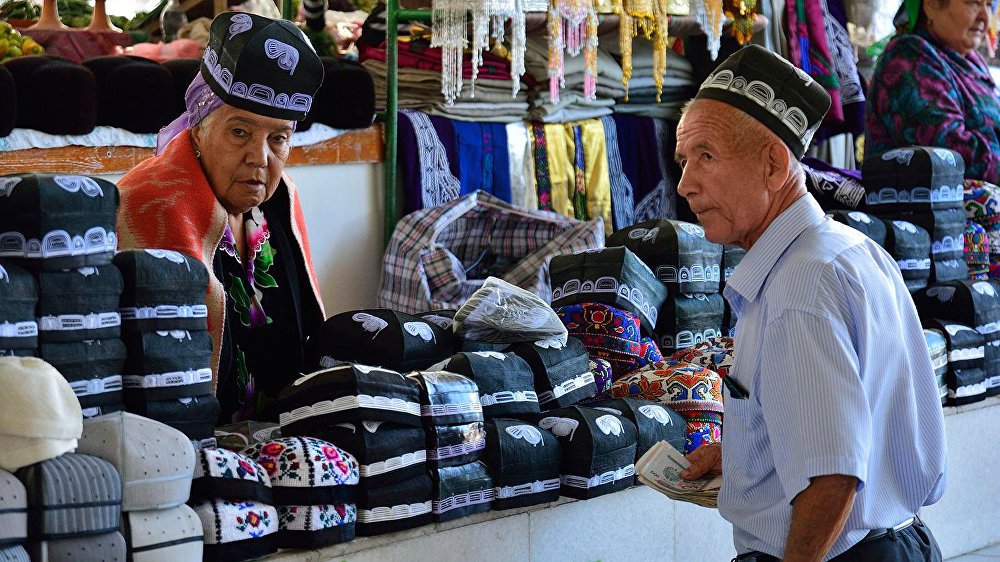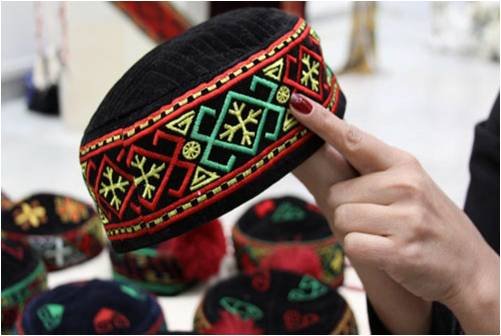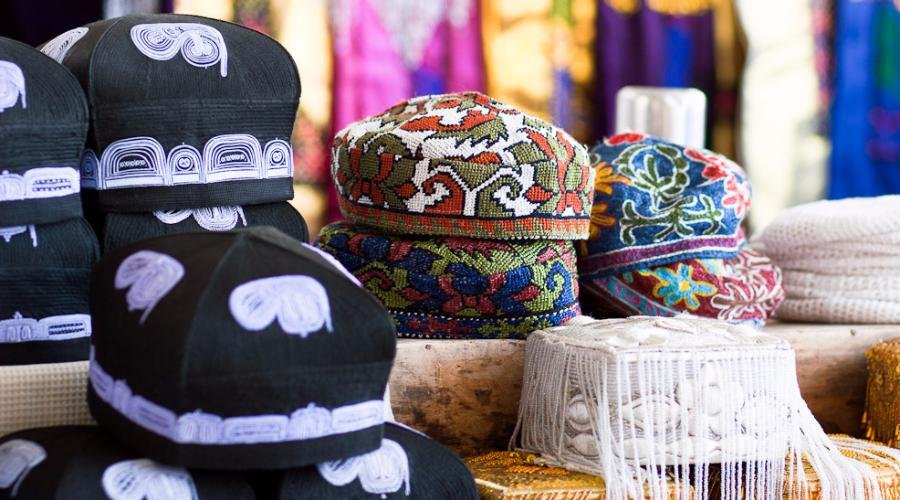Uzbek skullcap: the origin of the headdress and its symbolism
A skullcap deployed like a sunlit expanse: here, any detail found with a steadfast gaze bursts into consciousness and freezes. And you literally feel the compositional logic of each fragment, where on the curl alone you can study the laws of visual composition. The ornament of the national skullcap is incredible harmony. At first glance, everything is extremely simple, but it is this openness that causes unimaginable interest and unspeakable delight. The black dome sets off the crown of the head. There are four curls on it: almonds or peppers, or a bird’s wing… Chust’s craftswomen put all their kindness and warmth into them.
A look into the past
This traditional headdress of the Central Asian peoples, along with the preservation of common features, has always been distinguished by the individual style of the masters who created it. The history of skullcaps goes back centuries. The high artistic merits of skullcaps and ornamental images of embroideries prove a long way of development of this variety of folk art. Indirect confirmation of the existence of hats resembling skullcaps, even in ancient times, can be found in sculpture, wall painting, terracotta figurines in oriental miniature of the XV-XVI centuries.
The skullcaps of Uzbekistan are divided into several groups: Tashkent, Ferghana, Samarkand, Bukhara, Kashkadarya-Surkhandarya, Khorezm-Karakalpak, as well as several types: male, female, children’s and skullcaps for the elderly. Elderly women do not wear skullcaps.

The culmination of the development of the dressing of the skullcap as a kind of art of the national costume was the end of the 19th – mid-20th centuries, when the skullcap begins to carry in itself primarily an artistic and aesthetic function.
Until the 20th century, the shape, color and ornamentation of the skullcap were specific for each ethnic group – each district had its own style, there were separate ornamental motifs. At the same time, under the influence of economic, social and cultural changes in the life of the peoples of Central Asia, the style of skullcaps began to change – the masters began to use new fabrics, colored threads and artificial dyes. At the same time, the shape of the headgear is gradually beginning to change.
If initially it was cone-shaped, then starting from the 20s of the last century the shape becomes more diverse: pointed, hemispherical, round, tetrahedral. Already at the beginning of the last century, solely men sewed and embroidered skullcaps, but later this craft fell into the hands of women.
Treasure chest of national craft
The most common national headdress in Uzbekistan for men is the duppy skullcaps, which are sewn in the Ferghana Valley in the town of Chust, Namangan Region. The Chust skullcap is distinguished by its height – it is almost twice as high as the skullcaps made in neighboring Andijan. Embroidered patterns on the top and sides vary significantly. Craftsmen from Chust for a long time create unique hats, making each stitch exclusively by hand for songs.

“Embroidery on a skullcap is not just a beautiful decoration, it is a good parting word for the future owner,” said the craftsmen from the “Bogi-erom” mahalla in the Chust district. Here they attach tremendous importance to this. For example, patterns embroidered on a skullcap with white thread promise wealth, protect from an evil eye, and lead enemies astray. From ancient times this land was famous for its skilled craftsmen in embroidery “duppy”. And today, Chust’s girls – college graduates – successfully master this craft, creating truly masterpieces of national applied art.
All this only proves that in the skullcap you can trace not only the sacred beliefs of the ancient peoples, but also the life, culture, traditions of modern Uzbekistan. Therefore, it has become so personal and special thing that they give it only to the closest people or dear guests. The Chust’s craftswomen attach great importance to the material from which the headdress is made. Often when embroidering, they use only silk threads. The base of the skullcap can be varied – camel hair, velveteen, velvet, satin. The main thing is to comply with the technology and choose a natural and well-ventilated fabric.
The manufacture of “duppy” – from cutting to pressing occurs in several stages. Experienced craftswomen gather around themselves young needlewomen, each of whom performs her part of the work. One cuts out the necessary details, the other embroiders the upper pattern, the third, meanwhile, is preparing a dense base, and the fourth has already taken up sewing a whole skullcap from the components. At the very last stage, men are connected who give the “duppy” a traditional form by pressing.

It’s a pleasure to look at the process of making national skullcaps. This is something unbelievable when you get a real masterpiece of applied art from an ordinary patch of dark fabric and several spools of white thread. Chust’s craftswomen always argue. And all because they often get together and work on new models of skullcaps. In a good mood, having fun chatting with each other, the girls quickly learn the secrets of mastery.
All the main features of the Chust skullcapes and their varieties of “tus duppies” were found and processed by many generations of craftswomen. In the ornament of the Chust skullcap there are small graceful elements in the form of circles, droplets, twigs, forming a thin lace frame in conjunction with the main “bodom” pattern (almonds). In the bends “kalampir” (pepper), embroidered images of the ram’s head, a round rosette with a crosshair of the “wheel of life” stand out. The beauty of the form, its graphic nature, the proportionality of the “bodom” and “kalampir” motifs, correlated in color with the background; make it possible to attribute Chust skullcaps to the classical works of this applied art. Each craftswoman of Chust knows by heart the ornamental motifs of skullcaps, but at the same time she enriches her patterns in every possible way, fantasizes, and invents something of her own: the result is a masterpiece that is in great demand both in the local market and among foreign tourists.

“The mind, honor and conscience of a man lie in his skullcap,” says folk wisdom. It is not surprising that while walking along the eastern bazaar of any city in the Ferghana Valley, one can observe that almost every man wears a skullcap embroidered by Chust craftsmen.
From below, the skullcap is framed by black silk lace, over which wavy patterns are embroidered around the headdress. Each of them symbolizes one of the teeth of the crown. There are sixteen such patterns, four on each side. So, each owner of “duppy” wears a semblance of a royal crown on his head.

What are the symbols depicted on the skullcap?
The word “skullcap” came from the Turkic “tuba” – the top. The skullcaps are worn by grandfathers, men, women, girls, boys and even babies. Grandmothers, basically do not wear skullcaps, they tie a head with a variety of scarves. As mentioned earlier, there are several types of skullcaps, and each of them has a different texture, shape and palette. Each craftswoman knows by heart the ornamental motifs of the skullcaps, but she in every possible way enriches the patterns with her imagination, resulting in a masterpiece. The ornament, shape and color scheme of the skullcap can determine the age, status and place of residence of its owner.
So, let’s analyze the meaning of signs and symbols depicted on one of the most famous skullcaps in Uzbekistan, Chust skullcap. Firstly, the four sides of the skullcap designate protection against evil spirits from the four cardinal points. Secondly, black fabric – symbolizes space and darkness. The ornament with chilli peppers is considered a symbol of life, family well-being and a charm from the evil eye. The white threads with which the patterns are sewn are a cycle, a sign of the sun. 16 arches around the skullcap speak of the cyclical nature of life and death, and also promise wealth and vitality. The lamb horns depicted inside the arch means strength and courage.

The upper part of the skullcap is called – tepa, the middle – kizak and the lower – zhiyak. The skullcap is very convenient to store, as it folds well.
In the Ferghana Valley, in addition to the famous Chust skullcaps, Margilan ones are also produced, which are not inferior to the Chust ones in terms of prevalence. They have a sweet almond blossom on four sides – a baud that represents a happy marriage. The skullcap has a small dome height and sits comfortably on your head.
Types of skullcaps
Gold sewing Bukhara

Patterns embroidered on braid with gold and silver thread indicate the high social status of the holder of the skullcap or the sacredness of the event in connection with which it was worn. The popular skullcap images were “the nightingale’s eye,” “the sparrow’s tongue,” a dome, stars, or a circle representing the target.
Andijan (female)

The skullcap is embroidered on a dense white base with crosses. There are often depicted flowers, fruits and symbolic signs. The most common images are pomegranate, roses, and the “snake footprint”, which, as the ancestors believed, serves as a talisman.
Tashkent (female)

Bright feathers of birds – rooster, pheasant or peacock – protection from the evil eye. Made of burgundy, dark green or dark blue, embroidered with beads of light colors. The skullcap depicts not only symbolic patterns, but also figures of animals and plants.
Shakhrisabz (male)

It is also called “Iroki” – Iraqi (or “carpet” by production technology). When Tamerlan conquered the territory of modern Iraq, he brought the best craftsmen from there, including skullcaps. Floral ornament – a symbol of earthly life, thanks to the Creator for the beauty and generosity of nature.
Baysun (male)

Each color combination of fragments has a special sacred meaning. Yellow “pakhtagul”, cotton flower, white and diamond-shaped – “pakhtagul”, cotton itself. The skullcap has a fairly high rim. On the bottom it is decorated with a special strip – jiyak. It is also hand-woven and has a magical meaning; it is a guard against evil forces.
Karakalpak (male)

The round element in the form of a wheel on this skullcap is called the Karakalpak “Queen’s spit”. According to legend, in ancient times, one queen saw the beautiful work of embroiderers and spat, so as not to jinx it. This regal spit also fit into the ornament. Since then, he serves as a talisman.
The Uzbek skullcap is not just a national headdress, it is part of history and culture. She can tell a lot about her owner. Moreover, each pattern on the skullcap is not a random detail, but a special sign.

